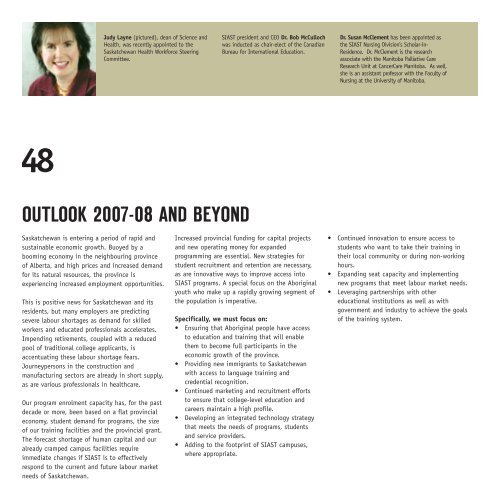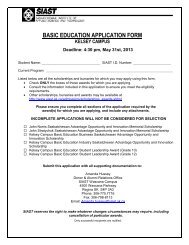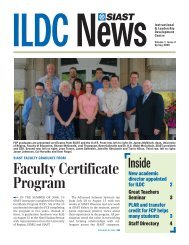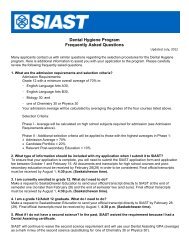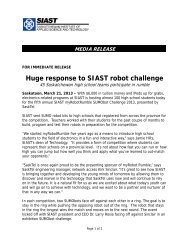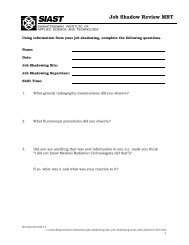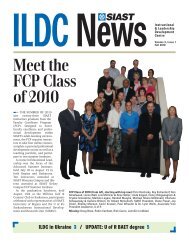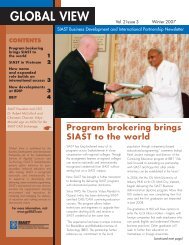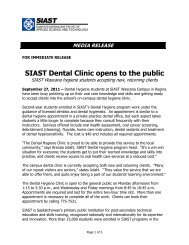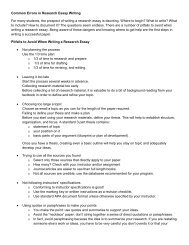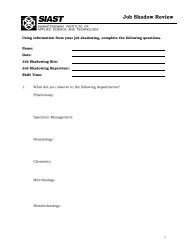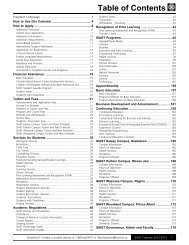siast 2006-2007 annual report - Saskatchewan Institute of Applied ...
siast 2006-2007 annual report - Saskatchewan Institute of Applied ...
siast 2006-2007 annual report - Saskatchewan Institute of Applied ...
You also want an ePaper? Increase the reach of your titles
YUMPU automatically turns print PDFs into web optimized ePapers that Google loves.
48<br />
Judy Layne (pictured), dean <strong>of</strong> Science and<br />
Health, was recently appointed to the<br />
<strong>Saskatchewan</strong> Health Workforce Steering<br />
Committee.<br />
OUTLOOK <strong>2007</strong>-08 AND BEYOND<br />
<strong>Saskatchewan</strong> is entering a period <strong>of</strong> rapid and<br />
sustainable economic growth. Buoyed by a<br />
booming economy in the neighbouring province<br />
<strong>of</strong> Alberta, and high prices and increased demand<br />
for its natural resources, the province is<br />
experiencing increased employment opportunities.<br />
This is positive news for <strong>Saskatchewan</strong> and its<br />
residents, but many employers are predicting<br />
severe labour shortages as demand for skilled<br />
workers and educated pr<strong>of</strong>essionals accelerates.<br />
Impending retirements, coupled with a reduced<br />
pool <strong>of</strong> traditional college applicants, is<br />
accentuating these labour shortage fears.<br />
Journeypersons in the construction and<br />
manufacturing sectors are already in short supply,<br />
as are various pr<strong>of</strong>essionals in healthcare.<br />
Our program enrolment capacity has, for the past<br />
decade or more, been based on a flat provincial<br />
economy, student demand for programs, the size<br />
<strong>of</strong> our training facilities and the provincial grant.<br />
The forecast shortage <strong>of</strong> human capital and our<br />
already cramped campus facilities require<br />
immediate changes if SIAST is to effectively<br />
respond to the current and future labour market<br />
needs <strong>of</strong> <strong>Saskatchewan</strong>.<br />
SIAST president and CEO Dr. Bob McCulloch<br />
was inducted as chair-elect <strong>of</strong> the Canadian<br />
Bureau for International Education.<br />
Increased provincial funding for capital projects<br />
and new operating money for expanded<br />
programming are essential. New strategies for<br />
student recruitment and retention are necessary,<br />
as are innovative ways to improve access into<br />
SIAST programs. A special focus on the Aboriginal<br />
youth who make up a rapidly growing segment <strong>of</strong><br />
the population is imperative.<br />
Specifically, we must focus on:<br />
• Ensuring that Aboriginal people have access<br />
to education and training that will enable<br />
them to become full participants in the<br />
economic growth <strong>of</strong> the province.<br />
• Providing new immigrants to <strong>Saskatchewan</strong><br />
with access to language training and<br />
credential recognition.<br />
• Continued marketing and recruitment efforts<br />
to ensure that college-level education and<br />
careers maintain a high pr<strong>of</strong>ile.<br />
• Developing an integrated technology strategy<br />
that meets the needs <strong>of</strong> programs, students<br />
and service providers.<br />
• Adding to the footprint <strong>of</strong> SIAST campuses,<br />
where appropriate.<br />
Dr. Susan McClement has been appointed as<br />
the SIAST Nursing Division’s Scholar-in-<br />
Residence. Dr. McClement is the research<br />
associate with the Manitoba Palliative Care<br />
Research Unit at CancerCare Manitoba. As well,<br />
she is an assistant pr<strong>of</strong>essor with the Faculty <strong>of</strong><br />
Nursing at the University <strong>of</strong> Manitoba.<br />
• Continued innovation to ensure access to<br />
students who want to take their training in<br />
their local community or during non-working<br />
hours.<br />
• Expanding seat capacity and implementing<br />
new programs that meet labour market needs.<br />
• Leveraging partnerships with other<br />
educational institutions as well as with<br />
government and industry to achieve the goals<br />
<strong>of</strong> the training system.


